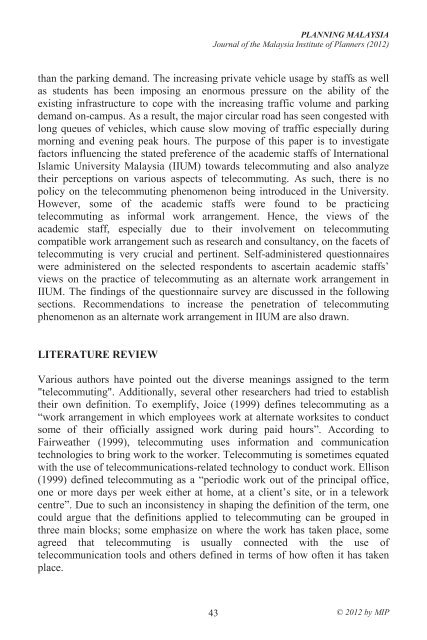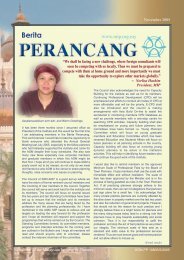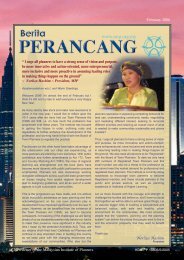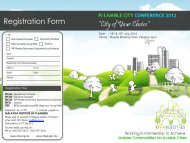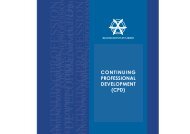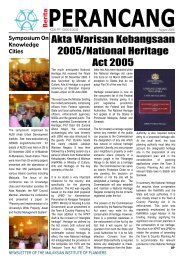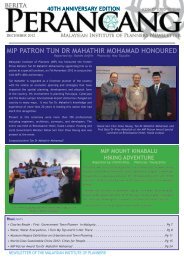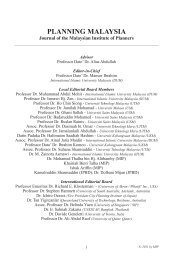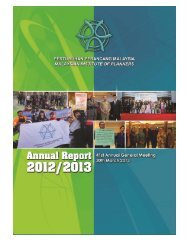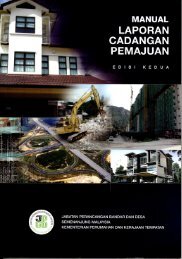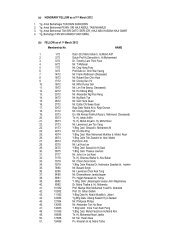Untitled - Malaysian Institute of Planners
Untitled - Malaysian Institute of Planners
Untitled - Malaysian Institute of Planners
Create successful ePaper yourself
Turn your PDF publications into a flip-book with our unique Google optimized e-Paper software.
PLANNING MALAYSIAJournal <strong>of</strong> the Malaysia <strong>Institute</strong> <strong>of</strong> <strong>Planners</strong> (2012)than the parking demand. The increasing private vehicle usage by staffs as wellas students has been imposing an enormous pressure on the ability <strong>of</strong> theexisting infrastructure to cope with the increasing traffic volume and parkingdemand on-campus. As a result, the major circular road has seen congested withlong queues <strong>of</strong> vehicles, which cause slow moving <strong>of</strong> traffic especially duringmorning and evening peak hours. The purpose <strong>of</strong> this paper is to investigatefactors influencing the stated preference <strong>of</strong> the academic staffs <strong>of</strong> InternationalIslamic University Malaysia (IIUM) towards telecommuting and also analyzetheir perceptions on various aspects <strong>of</strong> telecommuting. As such, there is nopolicy on the telecommuting phenomenon being introduced in the University.However, some <strong>of</strong> the academic staffs were found to be practicingtelecommuting as informal work arrangement. Hence, the views <strong>of</strong> theacademic staff, especially due to their involvement on telecommutingcompatible work arrangement such as research and consultancy, on the facets <strong>of</strong>telecommuting is very crucial and pertinent. Self-administered questionnaireswere administered on the selected respondents to ascertain academic staffs’views on the practice <strong>of</strong> telecommuting as an alternate work arrangement inIIUM. The findings <strong>of</strong> the questionnaire survey are discussed in the followingsections. Recommendations to increase the penetration <strong>of</strong> telecommutingphenomenon as an alternate work arrangement in IIUM are also drawn.LITERATURE REVIEWVarious authors have pointed out the diverse meanings assigned to the term"telecommuting". Additionally, several other researchers had tried to establishtheir own definition. To exemplify, Joice (1999) defines telecommuting as a“work arrangement in which employees work at alternate worksites to conductsome <strong>of</strong> their <strong>of</strong>ficially assigned work during paid hours”. According toFairweather (1999), telecommuting uses information and communicationtechnologies to bring work to the worker. Telecommuting is sometimes equatedwith the use <strong>of</strong> telecommunications-related technology to conduct work. Ellison(1999) defined telecommuting as a “periodic work out <strong>of</strong> the principal <strong>of</strong>fice,one or more days per week either at home, at a client’s site, or in a teleworkcentre”. Due to such an inconsistency in shaping the definition <strong>of</strong> the term, onecould argue that the definitions applied to telecommuting can be grouped inthree main blocks; some emphasize on where the work has taken place, someagreed that telecommuting is usually connected with the use <strong>of</strong>telecommunication tools and others defined in terms <strong>of</strong> how <strong>of</strong>ten it has takenplace.43© 2012 by MIP


